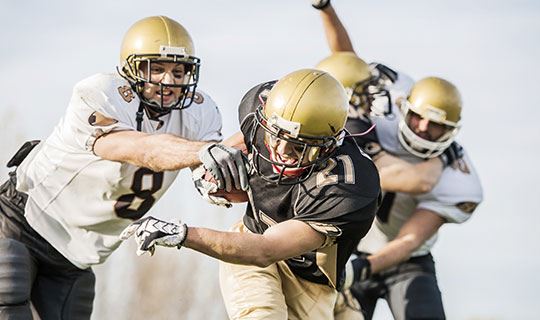
The roar of the crowd and the peak performance of athletes pushing their bodies to the limit are the hallmarks of many sports. But beneath the surface of this seemingly effortless display of athleticism lies a constant battle against injuries. Every sport takes a constant toll on the human body, from the explosive power needed for a jump shot to the intricate mechanics of a gymnast’s dismount.

“Injury prevention starts with education. Athletes need to be aware of their body’s limitations and listen to the signals it sends,” says Dr. Peter DeLuca, a renowned sports medicine expert with RWJBarnabas Health Medical Group and Cooperman Barnabas Medical Center, an RWJBarnabas Health facility. He has treated numerous professional athletes, from hockey players on the New Jersey Devils, to Gotham FC, a professional women’s soccer team. He also has treated high school athletes and college athletes. He emphasizes that sprains and strains, affecting ligaments and muscles respectively, are prevalent across most sports. However, certain sports, like baseball, throw their own curveballs when it comes to injuries.
Sprinting on the base paths can increase baseball players’ risk for hamstring strains. Because of the rotation movement with swinging the bat, a baseball player is also more prone to abdominal oblique muscle strains, Dr. DeLuca explains.
“Sports injuries are not confined to the field; they can have lasting effects on an athlete’s quality of life. That's why early intervention and comprehensive treatment are essential,” DeLuca says.
While some sports injuries are unavoidable, others can be prevented through proper preparation and conditioning. Dr. DeLuca emphasizes the importance of stretching before physical activity to prevent muscle and tendon strains, citing research that demonstrates the efficacy of stretching in reducing the risk of injury. “I always advise athletes to focus on flexibility and strength training, both in the offseason and during the season, to help reduce the risk of injury,” says Dr. DeLuca, adding, “Proper hydration is often overlooked, yet it plays a vital role in preventing muscle cramps and maintaining overall performance on the field.”
In the past few years, there’s been a noticeable rise in ACL tears among female athletes. Dr. DeLuca points to several reasons for this trend, such as shifts in training approaches and more involvement in high-impact sports. He emphasizes the significance of introducing exercise routines to lessen the likelihood of non-contact ACL tears.
“A proper warm-up gets your body ready to perform, while a cool-down helps prevent soreness. Think of it like preparing your car for a long drive – you wouldn't just jump in and go full speed,” Dr. DeLuca adds.
The Evolution of Sports Medicine: Diagnostics and Cutting-Edge Treatments
The world of sports medicine has revolutionized in recent years. The advent of MRI scans allows for a more precise diagnosis of injuries. “With MRIs, we know what structures are injured so that we can focus our rehab on that,” Dr. DeLuca explains. Thanks to this new approach, we now have rehab programs that help shorten recovery times for athletes.
Another exciting development is the field of orthobiologics, which utilizes a patient’s body to promote healing. One such treatment is PRP (platelet-rich plasma) therapy. This approach uses a patient’s blood to accelerate healing and reduce inflammation. Dr. DeLuca highlights the safety and effectiveness of PRP compared to traditional cortisone injections: “With PRP, there’s no downside to it; it’s your own blood. It has anti-inflammatory factors. Athletes are more willing to do that kind of therapy.” PRP therapy is effective in speeding up the healing process for ligament injuries, tennis elbow, and golfer’s elbow.
“As sports medicine evolves, so too must our approach to treatment,” DeLuca says. “We’re moving towards personalized therapies that optimize each athlete's recovery journey.”
From muscle strains to hamate bone fractures, professional and little league sports can take a toll on the body. However, proper warm-up, strength training, and hydration are crucial for injury prevention, and advances like MRI scans and PRP therapy are helping athletes recover faster and return to the sports they love.
Read full article at tapinto.net.